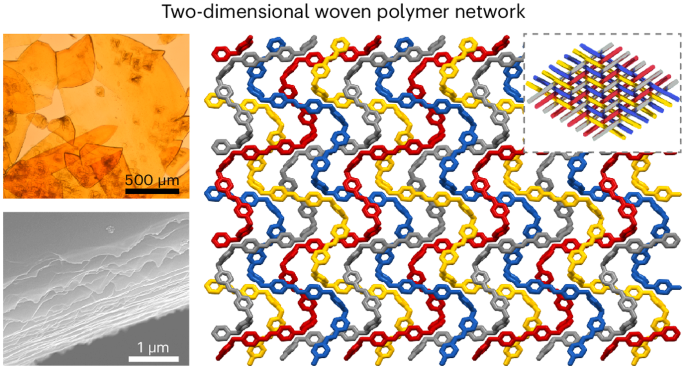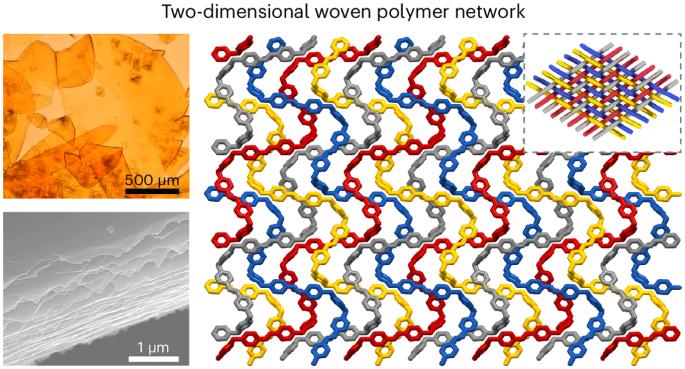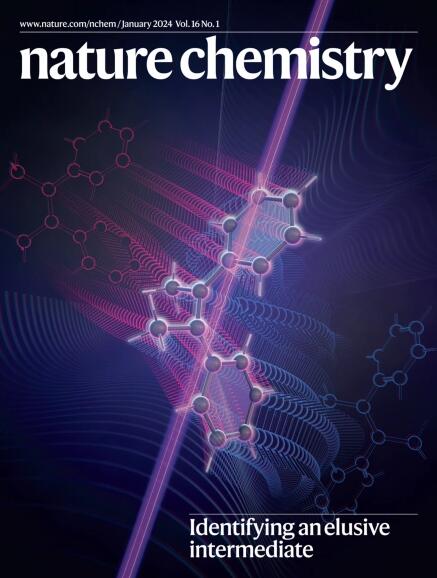纯有机独立二维编织聚合物网络单晶体。
IF 20.2
1区 化学
Q1 CHEMISTRY, MULTIDISCIPLINARY
引用次数: 0
摘要
宏观织物的美观性和实用性不断鼓励化学家将分子编织成交错的图案,目的是提供与其初始材料相比新出现的物理和化学特性。将纯有机分子线编织成完美无瑕的二维图案仍然是一项艰巨的挑战,尽管其可行性已被多次提出。在此,我们介绍了一种由双向 B-N 键驱动的无缺陷、纯有机、独立的二维编织聚合物网络的合成。我们获得了这种编织聚合物网络的单晶体,并通过 X 射线衍射分析揭示了其清晰的编织拓扑结构。使用 Scotch Magic Tape 从层状晶体中剥离出编织聚合物网络的独立二维单层纳米片。通过综合低剂量和低温电子显微镜成像技术研究了纳米片的表面特征。这些研究结果表明了纯有机编织聚合物网络的精确构造,并强调了在二维有机材料中应用编织拓扑结构的独特机遇。本文章由计算机程序翻译,如有差异,请以英文原文为准。


Single crystals of purely organic free-standing two-dimensional woven polymer networks
The aesthetic and practicality of macroscopic fabrics continue to encourage chemists to weave molecules into interlaced patterns with the aim of providing emergent physical and chemical properties when compared with their starting materials. Weaving purely organic molecular threads into flawless two-dimensional patterns remains a formidable challenge, even though its feasibility has been proposed on several occasions. Herein we describe the synthesis of a flawless, purely organic, free-standing two-dimensional woven polymer network driven by dative B−N bonds. Single crystals of this woven polymer network were obtained and its well-defined woven topology was revealed by X-ray diffraction analysis. Free-standing two-dimensional monolayer nanosheets of the woven polymer network were exfoliated from the layered crystals using Scotch Magic Tape. The surface features of the nanosheets were investigated by integrated low-dose and cryogenic electron microscopy imaging techniques. These findings demonstrate the precise construction of purely organic woven polymer networks and highlight the unique opportunities for the application of woven topologies in two-dimensional organic materials. Weaving purely organic molecular threads into two-dimensional patterns remains a formidable challenge. Now, driven by the formation of dative B–N bonds, a purely organic, two-dimensional and flawless woven polymer network has been prepared. In addition, free-standing monolayers of woven polymer nanosheets have been obtained through mechanical exfoliation.
求助全文
通过发布文献求助,成功后即可免费获取论文全文。
去求助
来源期刊

Nature chemistry
化学-化学综合
CiteScore
29.60
自引率
1.40%
发文量
226
审稿时长
1.7 months
期刊介绍:
Nature Chemistry is a monthly journal that publishes groundbreaking and significant research in all areas of chemistry. It covers traditional subjects such as analytical, inorganic, organic, and physical chemistry, as well as a wide range of other topics including catalysis, computational and theoretical chemistry, and environmental chemistry.
The journal also features interdisciplinary research at the interface of chemistry with biology, materials science, nanotechnology, and physics. Manuscripts detailing such multidisciplinary work are encouraged, as long as the central theme pertains to chemistry.
Aside from primary research, Nature Chemistry publishes review articles, news and views, research highlights from other journals, commentaries, book reviews, correspondence, and analysis of the broader chemical landscape. It also addresses crucial issues related to education, funding, policy, intellectual property, and the societal impact of chemistry.
Nature Chemistry is dedicated to ensuring the highest standards of original research through a fair and rigorous review process. It offers authors maximum visibility for their papers, access to a broad readership, exceptional copy editing and production standards, rapid publication, and independence from academic societies and other vested interests.
Overall, Nature Chemistry aims to be the authoritative voice of the global chemical community.
 求助内容:
求助内容: 应助结果提醒方式:
应助结果提醒方式:


